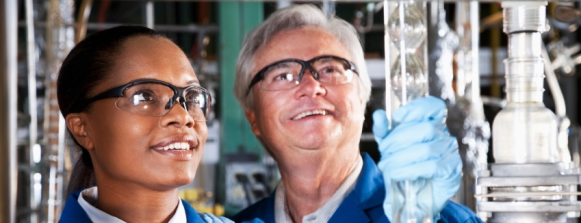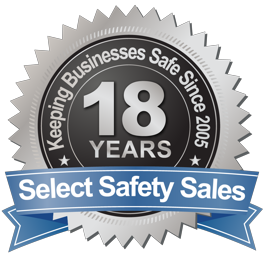| |

Safety Glasses And Eye Protection
More than 2000 people a day injure their eyes in a work related accident. It is estimated that protective eyewear can prevent up to 90% of work related eye injuries. The Bureau of Labor Statistics reports that eye injuries costs are well into the millions. Protect your employees and protect your business by making sure that all employees wear the proper eye protection.
In order to be sure that your employees are adequately protected, you first must assess their work area and identify the situations that pose the risk of eye injuries. This hazard assessment must first identify the type of hazards present in your workplace before deciding which type of protective eyewear to choose.
Determine the source and intensity of the hazard and the type of eye injury that can occur:
- Exposure to flying objects, particles or fragments requires safety glasses with side shields or goggles to be worn. If there is severe exposure to eye impact then face shields should be worn along with the glasses or goggles.
- Exposure to hot sparks, high temperatures or splashes from molten metal requires the use of safety glasses with special purpose lenses with side shields or goggles. Sometimes heat exposure will also require the use of a face shield along with glasses or goggles.
- Exposure to splashes, fumes, vapors and irritating mists from acid and chemical handling, blood, degreasing and plating requires safety goggles along with safety shields.
- Exposure to harmful dust requires the use of safety goggles to create a protective seal around the eye. You can choose from either eyecup or full cover safety goggles to be adequately protected.
- Exposure to heat, infrared, ultraviolet and reflected light radiation requires the use of filtered lenses. There should be a sufficient view of the work area with the filtered lenses but the shade can not go below the minimum standard.
Know the differences among the various forms of eye protection:
- Safety glasses (spectacles) come with non prescription and prescription lenses. The older styles had side shields whereas the newer ones provide side protection as wrap around glasses. Some styles have brow protections on the top of the frame.
- Goggles are stronger than safety glasses and form a protective seal around the eye. They can be purchased with direct venting which have tiny holes on the sides. These goggles will fog less but should not be used in dust or liquid hazard areas. Goggles with indirect venting should be used in these areas.
- For protection of a worker's face, in addition to his or her eyes, faceshields can be used ALONG with safety glasses and goggles. Faceshields should not be used in place of safety glasses or goggles.
There are three materials used for safety lenses. All three meet or exceed the requirements for protecting your eyes. Each one has different features to consider for a particular situation:
- Glass lenses are not easily scratched but can sometimes be heavy and uncomfortable. They also tend to fog.
- Plastic lenses are lighter than glass and not as likely to fog but not as scratch resistant as glass.
- Polycarbonate lenses are not as scratch resistant as glass but are lightweight, not likely to fog, stronger than glass or plastic and therefore more impact resistant.
Protective eyewear must meet the ANSI-Z87.1 eye and face protective standard. Safety eyewear must have Z87 or Z87+ marked on the frame and in some cases the lenses as well. There are different styles to choose from when purchasing protective eye equipment. It is important that eye protection fits properly in order to adequately protect from the exposure to hazards. The eyewear should also be comfortable so that the workers will keep it on their face. It is also helpful for them to have safety eyewear holders and straps for ease of accessibility. If its there, they will be more likely to put it on.
Eyewash Stations for Protection
Safety Glasses, Goggles and Shields are the first line of defense for the protection of vision in an industrial workplace. An eyewash station or multiple eyewash stations should be placed strategically in a plant or construction site for an accident that happens despite precautions that have been taken.
They should be placed within ten seconds of a hazardous area. Eyewash Stations in the Workplace are protection for your workers eyes.
Remember it is up to you, the employer, to have a policy that requires eye protection to be worn. This policy must be actively enforced!
References for these FAQ’s
- Center for Disease Control & Protection - Data & Statistics
- United States Department of Labor
The information on this page is an original copyrighted article. We welcome you to link this page from your website. However, copying this article in whole or in part is strictly prohibited.
Disclaimer: We have provided this article as general information on the use of this article. We make no claims as to the accuracy or completeness of the information as it may apply to an infinite amount of conditions and situations. It is the responsibility of the person or persons reading and using this information to refer to the instructions and information provided by the manufacturer in the product package before testing or using this product. Users of this information agree to hold Select Safety Sales LLC harmless from liability of any kind relating to the use of this information.
|
|






